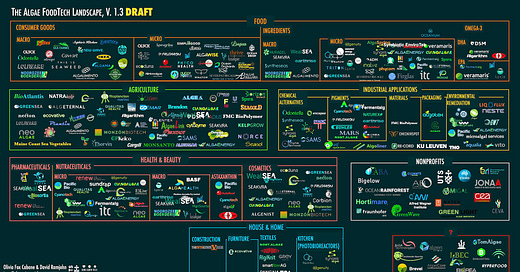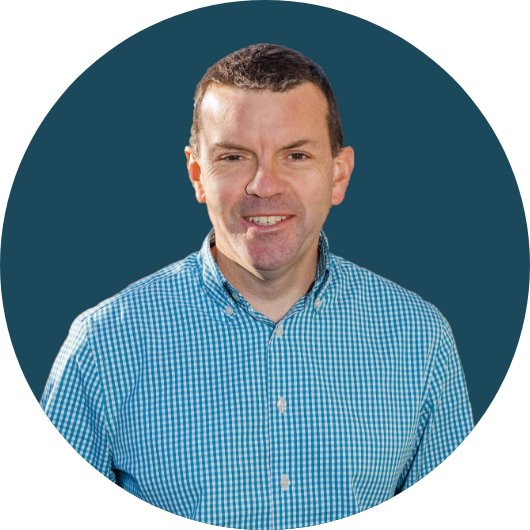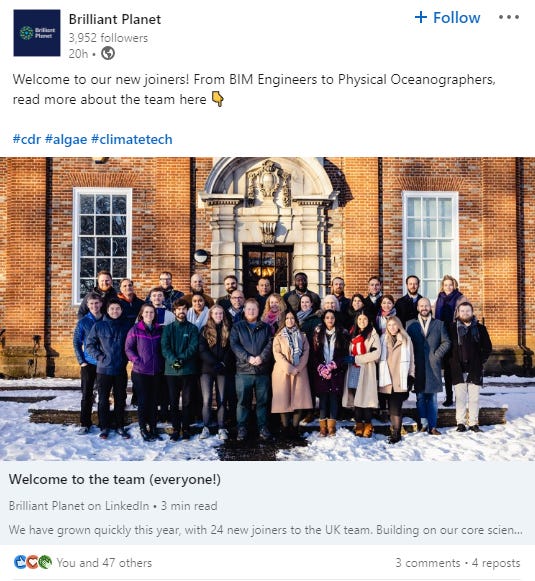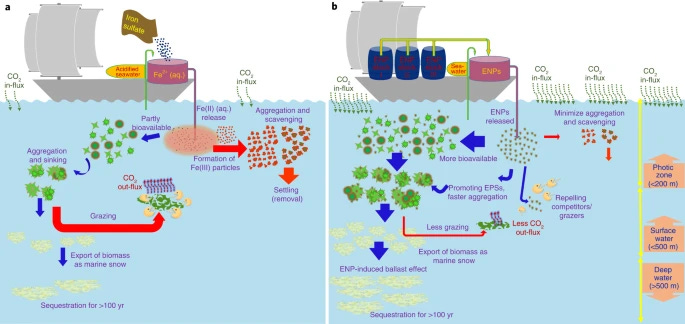🌊 Scaling seaweed sustainably with OCEANIUM
PLUS: Provectus Algae (Qld) receives $525,000, and Urchinomics gets kelp-bed restoration blue carbon credits
“Overall, we see the greatest potential for seaweed in food and chemicals/materials at a large scale, and see the value of food applications as a crucial step towards achieving that scale. " — Dr. Charlie Bavington, CTO of OCEANIUM
Dear algae technologists - hello and welcome to the Paxtier Report!
This week, check out the new and improved ‘Algae Foodtech Landscape’ created by The KindEarth.Tech (KET) Foundation, Peter Ralph's team at the University of Technology Sydney and the brilliant David Ramjohn:
(Read more HERE).
In today’s report:
Markets: 💸 Provectus Algae (Qld) has received $525,000 from the AMGC fund.
Deals: 🤝 Grupo EULEN is investing in the scientific start-up G2G Algae.
Movers and Shakers: 🌍 Scaling seaweed sustainably with OCEANIUM.
Around the web: 🍲 Alexiou Gibson sold over 100,000 jars of Sea Moss over a weekend.
Research Rundown: 📝 Using engineered nanoparticles to increase carbon dioxide storage in the ocean.
Markets and Investing
✂️Algae Market Snippets
Some big moves in recent weeks:
Provectus Algae (Qld) has received $525,000 from the AMGC fund. 👏 (Read more HERE).
£268,399 raised from 129 investors in a matter of days. Check out Seaweed Generation’s fundraising efforts. (Read more HERE).
European Union negotiators reached a political deal on Sunday to boost the EU carbon market. (Read more HERE).
Macro Oceans has opened a pilot manufacturing plant and lab in West Sacramento. 🌊 (Read more HERE).
Renewable energy developer Ørsted has partnered with UK-based SeaGrown to explore the role of seaweed farms in enhancing ocean biodiversity. 🐟 (Read more HERE).
🌊 Onami Foods is making waves in France. You can now catch their range of algae and plant-based fish & chips alternatives in Carrefour Île-de-France hypermarkets. These products include: KissKiss Nuggets, Crispy Tender, Mini Hug filet, and Filet XOXO. (Read more HERE).
Biodiversity start-up - basecamp research - raises $20 million. (Read more HERE).
Union Square Ventures has raised a new $200M Climate Fund. 🌍(Read more HERE).
Scottish seaweed start-up Kaly Group closes on seed round to develop farming operations. (Read more HERE).
Grupo EULEN is investing in the scientific start-up G2G Algae to boost research in microalgae cultivation and better understand algae's role in biodiversity enhancement. (Read more HERE).
Online sales of Arkhangelsk cosmetics, dietary supplements and functional nutrition from algae doubled compared to last year. (Read more HERE).
European Investment Fund pumps €50 million into climate tech VC World Fund. (Read more HERE).
Polar Algae have received 2.8 million Norwegian kroner to further develop high value algae extract components. (Read more HERE).
Corbion NV has begun a process to divest its non-core emulsifiers business and the Amsterdam-based company has created a new business unit for algae ingredients for the aquaculture industry with plans to expand into pet nutrition.(Read more HERE).
Univar and Kalsec expand distribution partnership: ‘We’re helping shape the future of food through ingredient innovation’. (Read more HERE).
US-based fund invests in Philippines seafood company, sets sight on $500 million reef fund. (HERE)
Kemin breaks into functional beverage market with dispersible form of algal immune health ingredient. (HERE)
DOE announces intent for funding to improve bioenergy feedstocks and optimize production of biofuels and biochemicals. (HERE)
Seaweed-based liver health product gears up for market launch. (HERE)
Urchin farming company gets world first blue carbon credit for kelp- bed restoration. (HERE)
In depth with Peter Green
🌍Scaling seaweed sustainably with OCEANIUM
Charlie Bavington is the co-founder of OCEANIUM, a biotech start-up developing innovative, all-natural products from sustainably sourced seaweed.
He has spent over two decades working in marine biotechnology R&D and, in 2005, also founded GlycoMar - a company researching and developing marine-based products for the healthcare, pharmaceutical, personal care, and nutritional markets.
In this snippet from our recent call, Charlie and I discuss the evolution of OCEANIUM, challenges facing the seaweed industry, and advice for others in the space.
How has OCEANIUM evolved to where it is now?
Karen, my co-founder, first discovered seaweed while studying sustainability at Cambridge. After deciding to start a business focused on this resource, she connected with me through the Knowledge Transfer Network and, at a conference in 2018, we discussed her idea for seaweed-derived biopackaging. We soon realised the full capability of seaweed as a versatile marine plant and decided it would be more commercially viable to explore biorefining technologies instead. This would allow us to produce multiple products with multiple "value streams".
We quickly conducted some techno-economic analyses to determine the feasibility of our venture and, when the scaling factors looked reasonable, we knew we had a strong chance of making it work.
After this, in 2018, we put in a lot of effort and managed to secure some grant funding from Sky Ocean Ventures and Innovate UK. This allowed us to conduct small-scale proof of concept pilot studies.
And since then, we’ve grown significantly and raised additional funds from friends, family, business angels, and accelerator programs. We also raised capital from the World Wildlife Fund and Builders Vision for our major seed round, which has allowed us to grow our team and develop an R&D facility as quickly as possible.
It was a deliberate choice to avoid vertical integration early on because we simply didn't have the resources to do it. Furthermore, the skills required for seaweed processing and biorefining are vastly different from those needed for seaweed farming. To account for this, we’ve been focused on building mutually beneficial partnerships with farmers for long-term supply and security. And we now sit in the middle of the supply chain, where we try to promote seaweed farming in the western hemisphere and push for the scale needed to make a measurable impact.
What’s next for OCEANIUM?
We are currently operating at a multi-tonne wet-weight scale and raising funds to build an industrial demonstrator with a 5000 tonne per year wet weight capacity.
What extracts from seaweed are you focused on and excited about?
Overall, we see the greatest potential for seaweed in food and chemicals/materials at a large scale, and see the value of food applications as a crucial step towards achieving that scale. To develop products in these markets, we currently use our technology to extract and purify soluble components from seaweed, including nutraceuticals and proteins. Meanwhile, insoluble components are processed separately to create our fiber product.
But beyond that, there are many potential new products and applications for seaweed that can drive additional value. For example, I see many potential applications for seaweed in healthcare. However, investing in healthcare can be risky and slow, so it makes sense to establish a solid processing business first.
What major challenges does the seaweed industry face?
One of the major challenges with seaweed is a lack of technology and analytical tools. In the pharmaceutical and healthcare industries, these tools are highly developed and easily accessible. But when working with marine biomass, some basic tools are lacking. This can make it difficult to process seaweed effectively and reliably.
Secondly, the seasonality and variability of feedstock can be a major challenge. There’s generally a lack of fundamental knowledge about the material, and this means we have to develop additional non-core technologies to help us produce a consistent product.
Finally, as a company, we are highly aware of the potential for unintended consequences arising from the establishment of a large-scale seaweed industry. To address this, we are working with a wide range of experts to conduct lifecycle analyses and assess the environmental impact of our work. This can be a challenging process for a start-up, but we are committed to ensuring that our work does not have unintended negative consequences. We would like to see the whole process become simpler and more accessible for companies like ours.
What advice would you give to someone else starting out on this journey?
As a scientist who has made many mistakes when starting a business, I would recommend that my younger self read the book "Disciplined Entrepreneurship" by the team at MIT's Sloan Management School. This book emphasises the importance of technology development, understanding your value proposition and market, and clearly stating these when presenting your technology as a business proposition.
If you’d like to learn more about OCEANIUM or join them in their mission, check out the company site here. You can also follow Charlie on LinkedIn here.
🐦Tweet of the week
📝Research Rundown: Using engineered nanoparticles to increase carbon dioxide storage in the ocean
THE BIG IDEA
Engineered nanoparticles could make artificial phytoplankton blooms more efficient at removing CO₂ from the atmosphere. And recent analysis conducted by Babakhani, P. et al., suggests the process could be made affordable, viable, and safe for marine ecosystems.
The problem
Artificial ocean fertilization involves adding nutrients, such as iron, to stimulate phytoplankton blooms on the ocean surface. These blooms can absorb large amounts of CO₂ through photosynthesis - with some of the phytoplankton eventually dying and sinking to the ocean floor, sequestering carbon in the process.
Babakhani, P. et al., recently highlighted how the efficiency of this approach is lower than expected due to particle aggregation and limitations on secondary nutrients and light…
… And that’s where engineered nanoparticles (ENPs) can provide a solution.
Here’s how:
“Coated with simple, cheap, and environmentally friendly polymers, ENPs, which range in size between 10 and 100 nanometres, could be highly controlled and specifically tuned for different ocean environments.
Surface coatings could help the particles attach to plankton. And some particles might have light-absorbing properties, which would allow plankton to consume and use more CO₂.”
Babakhani et al.’s assessments highlighted how the efficiency of CO₂ removal with ENPs is much higher than conventional methods. And data from 123 studies indicated that ENPs can enhance phytoplankton growth without harming marine ecosystems.
Be sure to check out…
How this technique could reduce the area of ocean that needs to be fertilized to achieve a noticeable reduction in atmospheric CO₂. It could also alleviate concerns about the risks of geoengineering the entire marine ecosystem. And the use of ENPs could also have co-benefits for fisheries and aquaculture.
🔥 What else was hot in algae tech?
Checkerspot releases algae-based plastic prototype kit for designers 🤩. (Read more HERE).
(Paper) Study unravels how ocean warming impacts the early development of Giant Kelp, which can aid conservation. (Read more HERE).
Congratulations to RegenAqua for winning the coveted Reef Champions Conservation Award. Their innovative technology is being recognized for its role in rehabilitating and restoring the Great Barrier Reef. (Read more HERE).
Experimental clothing brand Vollebak and biomaterials company Living Ink have teamed up to create a T-shirt using black dye made from algae. (Read more HERE).
This team is engineering photosynthesis in mammalian cells... (Read more HERE).
Spirulina from CO₂ emissions: Algae growing begins at AB Agri site in UK. (HERE).
Imperial College London's Climate Entrepreneurs Club will be running a pre-accelerator programme next year, where teams from top UK Universities will compete in developing sustainable business ideas. (Read more HERE).
Alexiou Gibson sold over 100,000 jars of Sea Moss over a weekend. (Read more HERE).
Notpla won £1 million in the Prince of Wales’ Earthshot Prize. And they're hiring! (Read more HERE).
Carbon Pulse will extend its news coverage to the emerging voluntary market for #biodiversity credits. (Read more HERE).
U.S. Architects SOM propose a design for a building that absorbs carbon throughout its life cycle. (Read more HERE).
Read more about the Hokkaido kelp farmers aiming to boost storage of 'blue carbon' in seaweed beds HERE.
(Paper) Water motion and pH jointly impact the availability of dissolved inorganic carbon to macroalgae (Read more HERE).
Jobs
Several positions open at Alga Biosciences - check them out here.
That’s all folks!
Thanks again for joining us this week. Hope you have a great day and stay tuned for more algae tech updates soon!
Peter








